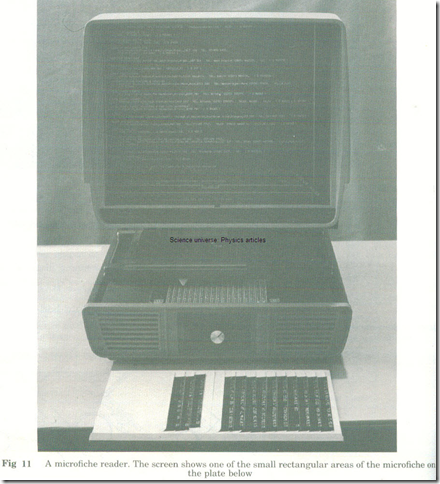Other Output Methods
OUTPUT ON TO MEDIA ALSO USED FOR INPUT
Media used include magnetic tapes and magnetic discs. Data is output on to them:
1 To input it to a computer again at a later date.
2 To drive a piece of equipment without the use of a computer. Magnetic tapes arc often used to drive plotters, lathes, etc.
COMPUTER OUTPUT ON MICROFICHE OR MICROFILM (COM)
A miniature display screen or a laser is used to produce output, much reduced, on high-quality film. Microfiche is a rectangular sheet of microfilm large enough to contain a number of pages (or frames) of data-typically 30 to 300.
Because of the reduction in size microfilm or microfiche cannot be read without a special reader to project the image on to a screen (Fig 11). With microfiche the material has to be moved into the correct position as only a small part of it is displayed on the screen. The microfiche reader is often fitted with fine adjustments to enable this to be done accurately.
Fig 11 A microfiche render’. The screen shows one of the small rectangular areas of the microfiche on the plate below
Advantages of COM
Over output on to paper
1 Graphics and/or text can be produced at very high speed (see Fig 12).
2 A large amount of data can be stored in a very small space.
Disadvantages
1 Cannot be read without special equipment.
2 Cannot be written on by hand.
Uses
1 To produce large quantities of output for storage in a small space.
2 To make data easy to carry around or send by post.
Examples of use of microfiche
1 A hank’s computer produces statements of clients’ accounts daily on microfiche, one sheet for each branch. These can then be sent cheaply by post to the branches.
2 A company may use microfiche to store old customer records.
3 To store diagrams of all the parts for a particular car. For many cars it is possible to obtain a microfiche showing all the parts together with all the part numbers. Purchasing spares is made much simpler because the assistant in the parts department has no trouble locating the correct part for that model.
4 To store library references (e.g. titles of books and extracts from them).
VOICE OUTPUT
Voice output from computers is generally easier and more successful than is voice recognition as a means of input. At first, voice output relied on the computer selecting appropriate words stored as sounds on magnetic tape. Now, however, voices can be successfully ‘synthesized’ by storing word patterns as bit strings. When the computer wants to ‘say’ something the appropriate codes are sent to a ‘voice response unit’ which produces the sounds.
Advantages
1 Can be accessed by telephone.
2 No reading ability is required by the user.
Disadvantages
1 it is not suitable for noisy environments.
2 There is no permanence-words not understood have to be repeated by the computer.
Uses
1 To produce a response from a computer by telephone without the need for a modem or terminal equipment at the user’s end of the line. If a push-button telephone is used, coded messages can be sent by pressing combinations of the buttons and the computer replies with synthesized speech.
2 Small hand-held devices are available which produce synthesized speech and which can:
(a) Make learning more interesting.
(b) Help with the translation of foreign languages.
DIRECT OUTPUT TO OTHER DEVICES
Computers are being used more and more to control other devices. These include aircraft, robots, central heating boilers, lathes, etc. The increased use of microprocessors has increased this type of application.
Any computer-controlled system may make use of the following:
1 Digital-to-analogue converters . This is because computers output digital signals. The devices that computers control are often analogue.
2 Actuators-an actuator is a device which can produce a movement when given an electrical signal.
3 Devices to switch large currents on and off. A computer only produces very low-power electrical signals. These cannot drive electrical equipment. To get a computer to do this the signal from a com puler has to switch another device on and off. Devices available are:
(a) Transistors-a transistor can be used to switch current on and off without any mechanical movement.
(b) Relays-a relay is a switch which can be switched on and off by a small current. It does involve a mechanical movement, but it can be used to switch more powerful equipment than can a transistor. In particular a relay can be used to switch on and off machines which work on mains electricity.
4 Motors-two types of motor might be used in a computer-controlled system:
(a) A continuous motor– this runs continuously and evenly when it is switched on. This type of motor has the advantage that it can run at high speeds.
(b) A stepper motor– when a signal is sent to a stepper motor it only rotates a small amount. To make it run continuously it has to be sent repeated signals. A stepper motor has the advantage that it can be controlled more accurately.

